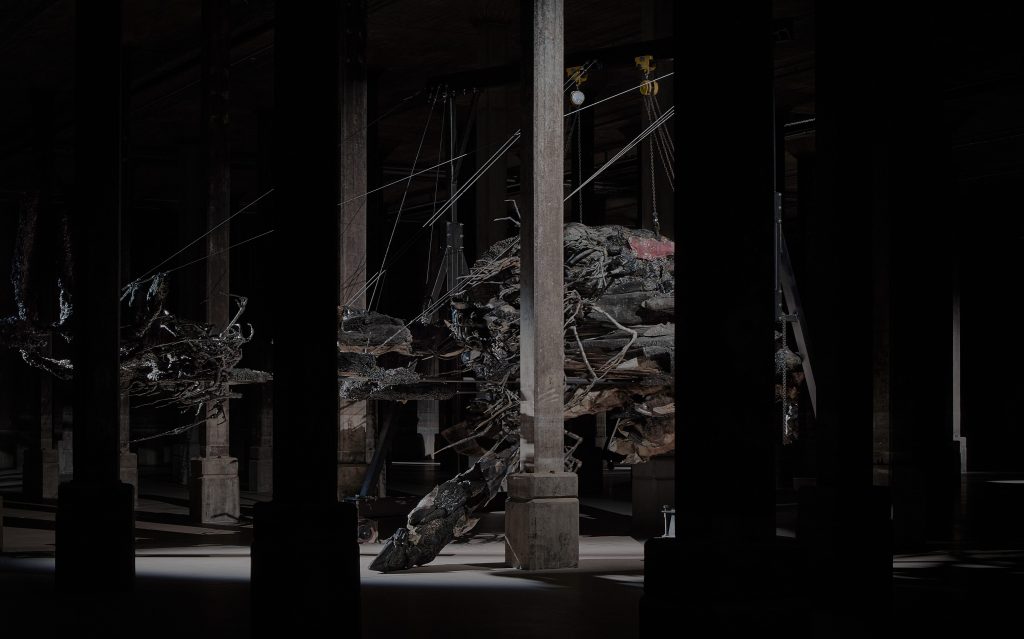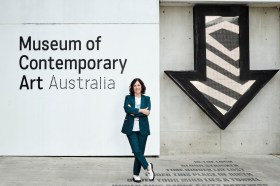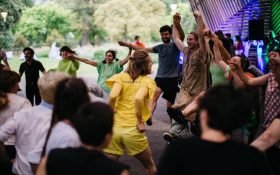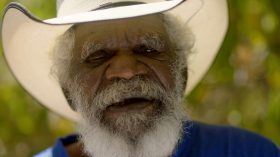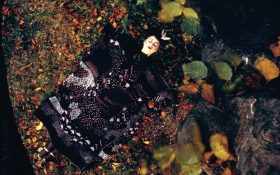An intraterrestrial sense of time is felt immediately as one enters The Tank in the new Art Gallery of New South Wales extension, situated in a former WWII oil tank. It’s a feeling that laps at the consciousness like waves, and heightens as roaming spotlights overhead slowly reveal the details and scale of The End of Imagination, the latest work by Argentine-Peruvian artist Adrián Villar Rojas.
It’s difficult to describe the works fully, because the sculptures are never completely revealed, but their forms are simultaneously familiar and at once alien. A single Jurassic tooth here, an outreaching claw or deformed machine arm there. In many ways, the exhibition’s title seems like a contradiction when so little is given.
Here, lighting becomes a form of narrative, programmed to operate like ’sentient beings’, spontaneous in their decision on where to ’look’. What is revealed to the viewer is completely out of one’s control, in turn signalling a level of agency one must surrender in order to experience Villar Rojas’ five monumental sculptures.
According to the artist, part of the work is about de-centering the human aspect to focus on the lives of the sculptures and their histories of trauma and decay. It’s an interrogation into both the digital, non-material world and the material world, with the sculptures first existing as digital models in simulated environments of extreme conditions. However, some of this conceptual rigorousness is lost when the works are actually presented in their material forms.
While The End of Imagination is undeniably an experience at the international biennale level in terms of scale, fabrication and complexity of process, at times it feels almost Hollywood-like in presentation – full of visual spectacle but lacking in that deeper nuance which sends shivers up your spine post the initial ‘wow’ moment.
A comparison might be Villar Rojas’ series of waterfront sculptures at the 2015 Istanbul Biennale, The Most Beautiful of All Mothers, which had a similar material quality reflecting on humanity, life, and decay.
Part of this shortcoming is perhaps due to the strong architectural characteristics of The Tank; characteristics which are visible before one sees the works themselves – specifically, a dense array of seven-metre high columns (125 in total) that punctuate the entire space and which are described by curator Justin Paton as ’the sixth sculpture’.
There are many examples of repurposed spaces which seamlessly harboured artworks without distracting from the show, while simultaneously adding a layer of complexity to its context. For example, the lower level of New York’s Dia Beacon – the loading bay of a former Nabisco box-printing factory – has a similar layout, albeit of smaller scale.
This reviewer is reminded of François Morellet’s No End Neon (1990/2017) in which the neon tubes embodied the likeness of a school of fish surfing between the columns, and more recently DJ Carl Craig’s Party/After Party (2020-21), which The New York Times described as ‘an immensely cunning meld of factory, nightclub and art gallery’.
There is also Kara Walker’s A Subtlety, or the Marvellous Sugar Baby (2014) which featured a 10-metre high sugar-coated sphinx situated in the old Williamsburg Domino Sugar factory, and which spoke to the degradation of African slave workers.
Read: ‘Air’ is a powerful and welcome successor to ‘Water’
Closer to home, Tanks Arts Centre in Cairns also had a former life as WWII oil tanks. A satellite venue of the Cairns Indigenous Art Fair, the Tanks Arts Centre’s history-laden site became an immersive backdrop to Sonja Carmichael and Elisa Jane Carmichael’s large-scale cyanotypes earlier this year.
While The End of Imagination is also site-specific and made to measure, it feels almost predictable that the subterranean bunker beneath AGNSW would house these beasts of industrial residue.
There is something about The End of Imagination that misses the mark, or goes too far, in terms of making use of this demanding space as the opening commission of Sydney Modern. Instead of reimagining AGNSW’s old oil tank, it plays to its rules, to the detriment of a sophisticated practice that never fully comes into the light.
The End of Imagination runs until mid-2023 at AGNSW, North Building Lower Level 4, The Tank. Free, bookings required.
The writer travelled to Sydney as a guest of Destination NSW.
